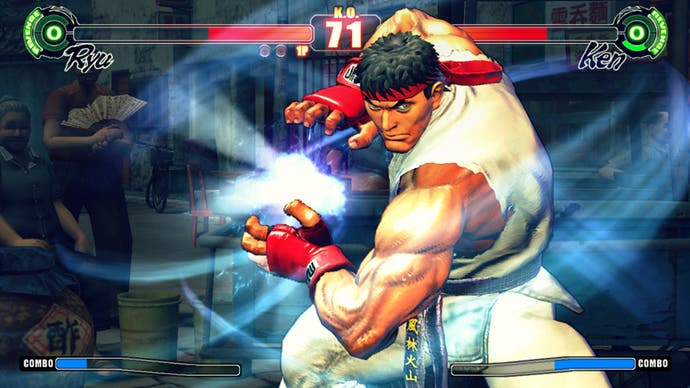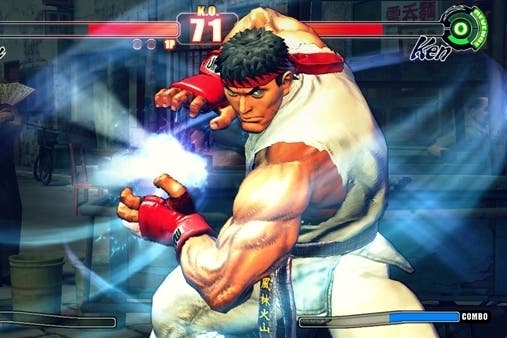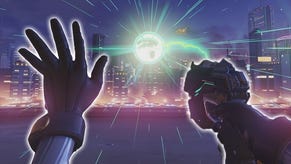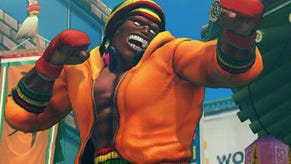Street Fighter 4 is so good maybe we don't need a sequel just yet
From the archive: Indestructible.
Every Sunday we bring you an article from our archive, either for you to discover for the first time to read all over again. Today, to mark the recent announcement of Street Fighter 5, we present Wesley Yin-Poole's look back at Street Fighter 4, first published as part of our games of the generation series.
2009. It had been 10 long years since a brand new Street Fighter had been released, for whatever reason: too hardcore, too niche, or, as many believed, Capcom had milked its cash cow so violently for so long that all that remained was a shrivelled, six-button corpse.
We dared to hope Street Fighter 4 would revitalise what had become a distant, stand-offish series. That's all we were asking for. That's all we expected. That, for Street Fighter fans the world over, would have been enough.
As it turned out, it achieved so much more.
Street Fighter 4 single-handedly revitalised the fighting genre for an entire industry and, for those who were there during the glory years of the 16-bit era, for those who toiled over 10-hit combos in Tekken and for those who mastered the parry and thrust of Soulcalibur, breathed new life into rusty quarter circle forward motions. Even the most die-hard Street Fighter fan will admit - whispered in back alleys only - that Mortal Kombat 9 turned out okay in the end.
But why? Was it fate? Was Street Fighter's triumphant return a case of being in the right place at the right time? Perhaps. My answer is a simple one: Street Fighter 4 achieved all of the above because it's the greatest fighting game ever made.
Capcom and producer Yoshonori Ono intended for Street Fighter 4 to celebrate the series' heritage, but they also needed it to be accessible. They needed it to be more pick up and play than the complex Street Fighter 3 with its Parries and Super Arts.
Capcom's master plan was to design a game that would attract lapsed Street Fighter 2 players back into the fold. Despite the initially controversial 2.5D cel-shaded visuals (like The Legend of Zelda: The Wind Waker, Street Fighter 4's detailed, expressive graphics get increasingly gorgeous with each passing year), and the addition of a handful of new characters with - shock! - new play styles, the gameplay would work similarly to Street Fighter 2's.
The combat is fixed to a 2D plane with the eight original World Warriors and four boss characters and their famous special moves working as they did back in the day. This, coupled with a relatively slow pace, made for a familiar, manageable experience. Capcom hoped those who played Street Fighter 2 back on the SNES and Mega Drive would spot Street Fighter 4 and think, I remember that, give it a shot, and have some fun while rekindling childhood memories of bleeding thumbs, bloodshot eyes and 15-inch CRTs.
Street Fighter 4 achieved all of this. Success!
The fighting game community, though, needed more than rose-tinted familiarity before granting their coveted seal of approval. As with all fighting games, they demand a balanced roster of characters, combat with depth and a combo system that, as they put it, provides them with a platform to show off their technology.
Street Fighter 4's greatest achievement is it delights expert and casual Street Fighter players with equal aplomb. It's the Toy Story of fighting games.
"Street Fighter 4's greatest achievement is it delights expert and casual Street Fighter players with equal aplomb. It's the Toy Story of fighting games."

Key to everything that is good about Street Fighter 4 is the Focus Attack, one of this generation's most inspired design decisions. Triggered by pressing medium punch and medium kick at the same time, it allowed characters to absorb an attack, filling up their Ultra Combo meter in the process, before launching a counter attack. Taken at face value, the Focus Attack makes dramatic comebacks more common than in any previous Street Fighter game. Under the hood, though, more was going on.
The Focus Attack comes in three types: the longer you hold down the buttons the longer the Focus Attack animation, the longer the window of hit absorption and the more powerful the counter attack. Hold down the buttons long enough and you'll trigger an unblockable attack, crumpling your opponent into sitting duck status, leaving you free to launch some devastating, damaging combo.
It makes for a more strategic game, a battle of wits that's less about combos and quick reactions (although combos and quick reactions of course are important) and more about mind games and zoning. The best players are those who get into their opponent's head, who accurately predict what they will do next, and who punish accordingly.
The cherry on the cake is the Focus Attack Dash Cancel, an advanced technique that gets the FGC up on their feet at fighting game tournaments. You can cancel the animation of a special move with a Focus Attack and, then, if your brain can make your fingers go fast enough, cancel the Focus Attack animation by dashing forward, giving you a split second to finish with a high damage, crowd-pleasing, back-breaking Ultra Combo.
Take Ryu's Shoryuken FADC into Metsu Hadouken Ultra Combo, for example. The input command is particularly complex: forward, down, forward and punch for the Shoryuken, cancel with the Focus Attack, dash forward to cancel the Focus Attack (double tap forward) then the Metsu Hadouken Ultra Combo (two quarter circle forward motions and all three punches).
Techniques such as this make Street Fighter 4 as much fun to play as it is to watch - by experts and the uninitiated alike. Matches can appear slow and, sometimes, boring, as players feel each other out. But they can also end spectacularly - a smart prediction, a quick reaction, a flurry of fingers, an FADC into an Ultra Combo. KO! Indestructible. The crowd goes wild. Jump out of your seat. Punch the air. It's Ali taking a hit to the ribs as he weaves into position for... bang! Uppercut. Lights out.

Now, nearly five years after release, Street Fighter 4 is still the most-played fighting game on the planet. It enjoys top billing at EVO, the biggest fighting game tournament. Its nostalgia-fuelled accessibility ensured critical and commercial success upon release, but its enduring popularity makes it deserving of a place in the pantheon of this generation's best multiplayer games.
History repeats itself. Companies burnt by their own mistakes seem hell bent on repeating them. Capcom's released no fewer than three iterations of Street Fighter 4 over the last five years, and while there is a decent amount of interest in the fourth - Ultra Street Fighter 4 - it's fighting game community fan service at best. The last couple of years have been somewhat depressing for fighting games fans: Street Fighter x Tekken, SoulCalibur 5 and Tekken 6 all failed to reach the heights Street Fighter 4 so effortlessly climbed. To survive, fighting game makers have turned to the free-to-play business model, risking a mauling from the FGC in the process.
Every now and then you hear Yoshinori Ono evade the burning question: when's Street Fighter 5 coming out?
I understand the question. The thought of a new entry in the series powered by next-generation consoles is truly exciting. But I've come to realise I don't want there to be a Street Fighter 5 for a very, very long time. Perhaps even for another five years. I mean, with Street Fighter 4 still so good, what's the point?















